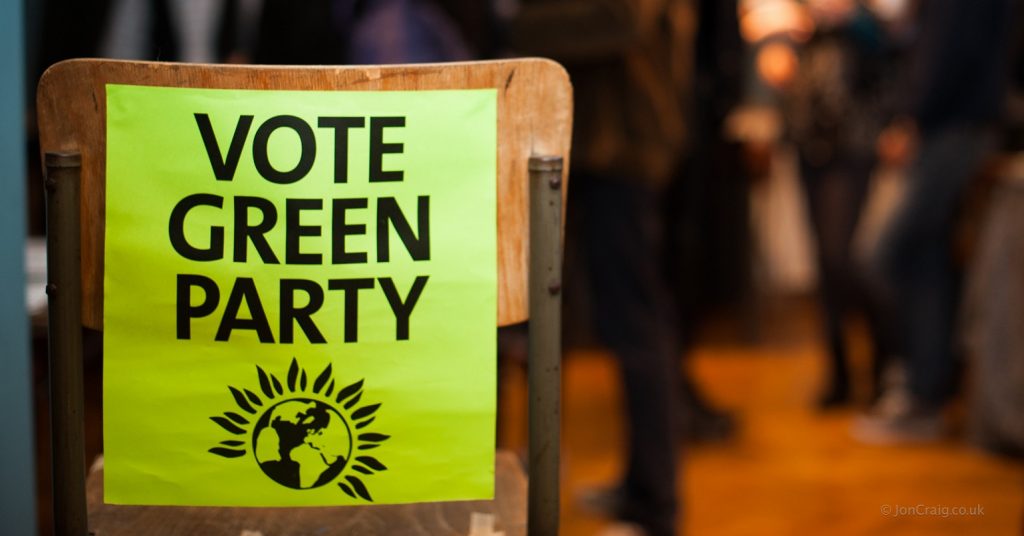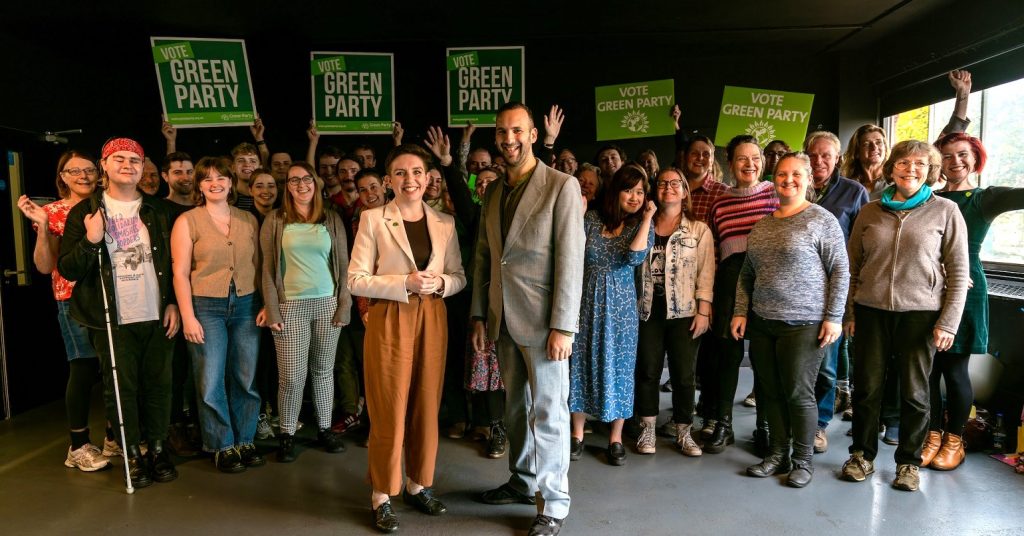100 days to go: six thoughts on the Greens and May

We are just 100 days away from the General Election.
With this in mind, let’s look at the Greens prospects for May and the months ahead.
1. The effect of both the steady Green surge of 2014 (doubled membership) and the Green tidal wave that has been January thus far (membership leaping past UKIP and the Lib Dems to nearly 55,000) on the Greens’ seat prospects are by no means clear.
It is very likely – touch wood – that Caroline Lucas will keep her seat. What will happen in Bristol West and Norwich South though is extremely uncertain, with us standing a fair chance in Bristol – a city with the second highest Green Party membership in England & Wales after Brighton. Whether our final vote share under First Past the Post will actually match our current polling levels of ~9% is also unclear. People, sadly, do vote tactically, and surges don’t last forever. But we can hope. Moreover, there will be plenty of council seats on May 7th for Greens to win.
What is clear is that our national vote share will be significantly higher than in 2010 (1%) – with a 5%+ average vote meaning dozens more candidates will at the very least keep their deposits. At £500 a pop, that’s good news in itself, but even better news for the narrative that the Greens are a growing party, and setting us up well for 2020.
One thing is certain – we have a lot more feet on the ground, a lot more campaigning acumen (recruiting campaign co-ordinators in every region) and a lot more money; both through increased subs income, extensive use of crowdfunding, and things like, you know, Vivienne Westwood’s £300k donation.
2. The Labour attack dogs are out.
This has been clear for a while, with the establishment of the Sadiq Khan led anti-Green unit. But Labour will be jumping on any policy flaws or cock-ups by Green candidates in the coming months – and promptly sending them off to the press. We have to be on guard.
3. The media have spotted the Greens, at last. But…
While media coverage is excellent for our profile – it’s a double edged sword. They will do anything they can to pick apart party statements, past embarrassments, internal spats and minor controversies. This week we saw an article in almost every paper picking up one side comment from Natalie Bennett on putting the Queen in a council house. The Telegraph went further in a piece called ‘Drugs, brothels, al-Qaeda and the Beyonce tax: the Green Party’s plan for Britain’, while the Spectator followed suit. And today’s Sunday Politics interview with Natalie Bennett was shocking, in the sense that Andrew Neil was at his most vicious, consistently picking on obscure policies and refusing to let Natalie answer. His treatment of Jim Murphy was, funnily enough, incredibly tame.
What is interesting is that many of the attacks are coming out in the right-wing press, rather than from more centrist/lefty media operations that would in theory back a Labour win. What does this mean? Well, the right are getting scared that Green party policies might actually get implemented.
4. The TV debates will be a game-changer.
Being excluded was already a huge victory – it energised activists, bolstered the narrative of the ‘alternative’ and the ‘underdog’, boosted our coverage and recruited thousands. But being included in the debates could do the same – it will establish us as a truly ‘major’ party, whatever Ofcom says. In part of course, this depends on performance – Natalie will have to do well to see anything like the Cleggmania of 2010 happen for the Greens (a poisoned chalice?). But the very act of appearing on two of the three debates will set a precedent: having boosted our 2010 vote, we’ll have to be in the 2020 debates, too.
5. Voter registration and core demographic turnout will be key for the Greens.
Our support is incredibly strong among students. Yet under the new voter registration system, nearly a million people could be left off the Electoral Roll – mostly students. We need to get them registered and get them out on polling day, something which will need the kind of organisational structure and efficiency we’ve not traditionally been famous for as a party.
6. The next government could be the most left-wing we’ve had in decades.
All the predictions are that Labour will be the biggest party, but not by much, meaning the minority government could have to rely on SNP, Plaid and potentially one (or more!) Greens’ votes. The red lines have already been drawn, and the latter three parties – a parliamentary left-wing alliance – have set Trident as their condition for a confidence and supply agreement. Labour are in meltdown in Scotland, on track to win as few as four seats to the SNP’s 55. Austerity and rail renationalisation will of course be two other agreement-breakers. Add to the potential Europe-wide ramifications of Sunday’s Syriza election victory in Greece, and it could be bye-bye neoliberalism. Let’s hope so.
See you on the doorstep.




I personally think the main focus should be on engaging a new generation of young voters as they are the ones who haven’t been tainted by the outdated two party politics that older generations have been at the mercy of.
But I agree that cautious comments that can’t be twisted are definitely required. We expect these from the current profiteers and charlatans we are at the mercy of, though it hasn’t been enough to get us out of our current rut politically.
I think it should also be a focus of the Greens to blow open the current inherent corruption in the ruling classes, as the historic peadophilia and cover ups (as well as the blatant profiteering and cronyism) is definitely something that could be a game changer.
and this isn’t about smear, rather it’s more to do with protecting society from sociopaths and parliamentary pirates.
And most of all, honesty.
I agree with Scott. Citizens income and wealth tax are not obscure policies. To suggest taking away the 9-10,000.00 threshold before paying tax so that everyone in the country including the moderately and well off can receive 72.00 a week is serious. Some people literally have a choice of eat or heat and that 9-10,000.00 tax relief is a lifeline. Please, you really need to think through these policies. Listening to the Natalie Bennett interview on Sunday Politics was embarrassing. Andrew Neil had done his homework and was showing the Green Party (and the rest of the watchers) the weaknesses in their policies, and knew more about it than Natalie. Embarrassing, but vital information. The Green Party need to become more professional – in honing their policies and in being able to support them in the face of such criticism. And to link the Green Party with the acceptance of ISIS! If you cant get rid of that one then I’m certainly not voting Green again! ISIS are not so much religious as common murderers.
The weekly tax on £10000/year or less a year would be significantly less than £72 so people on less than that would be better off with a citizens income than with the income threshold. As long as low income people didn’t lose out with regards to income that currently comes in the form of tax credits I’m not seeing an issue.
Very good point Becka. The £72 a week would be offset for people earning more than the personal allowance. There are approx 29 million tax payers each receiving the £10k personal allowance which is worth £38.46 per week. They would lose that but gain £72. So the actual cost would be £33.54 per week for those people. People receiving pensions are already receiving more than this so you can take them out of the equation as well as people in receipt of tax credits (about 5 million people), people on JSA (1.4m) Invalidity benefits, etc.
So the actual cost would be far less than the headline figure. Plus of course people would tend to spend the extra money, boosting economic activity, or save it which could provide a fund to top up a future pension. People could decide to reduce their work hours making more jobs available and potentially reducing or ending unemployment. Children could save their income and use it to pay for university or other education or as a deposit for a house. Wealthy people could see it as a small rebate on the extra tax they have to pay. The potential benefits to society are enormous.
It’s the kind of idea that almost sounds too good to be true but in fact there are very few downsides – mainly the large saving in Admin costs which actually means making a huge number of people redundant. That would have to be very carefully managed to avoid huge distress and hardship.
http://www.newstatesman.com/politics/2014/08/citizens-income-71-week-person-would-make-britain-fairer
http://www.citizensincome.org/FAQs.htm
http://www.citizensincome.org/filelibrary/booklet2013.pdf
Yes agree with Becka, the £10000 tax threshhold is irrelevant in the argument for CI. I didn’t think Natalie explained well that CI will be paid for by a host of taxes from people who can afford it and nearly everyone will be paying income tax instead of the situation now where the very poor and the very rich do not pay IT.
Thought the interview should be watched by all green candidates as it highlighted the kind of questioning we are likely to receive. I agreed with all the GP policies brought up by AN but did not think Natalie was good in explaining them partly because they are not easy explain in a few lines whilst under pressure. That unfortunately is what politicians have to do; but most are parroting the elite line which is an relatively easy soundbite to swallow if you have got most of your info from the mainstream media whilst the greens are stating the radical which is much harder to digest even though much healthier for all imo .
Rob
I wouldn’t classify citizens income and a wealth tax as obscure policies. The Telegraph hatchet job focused on obscure ones. And I wouldn’t even call Neil’s interview particularly vicious. It’s what we need to expect from now on, rigorous and forensic criticism.